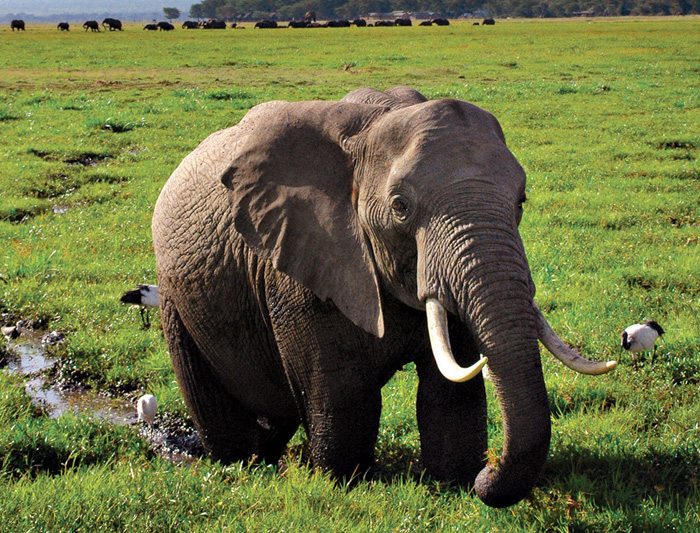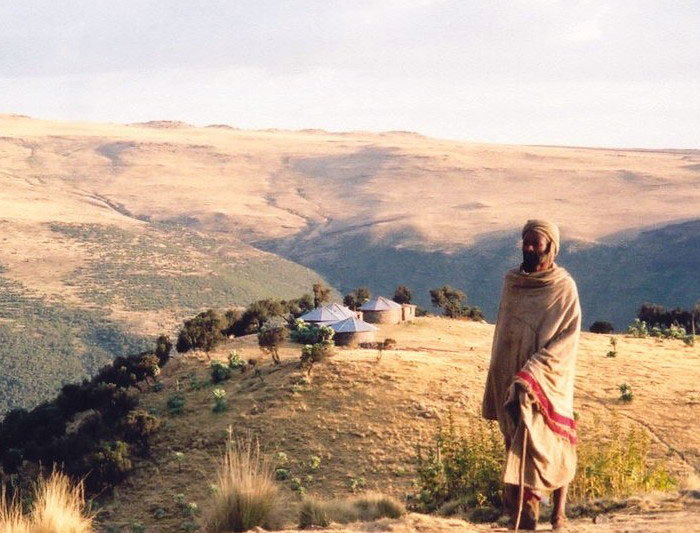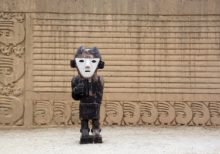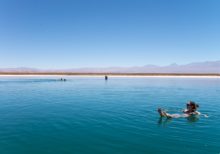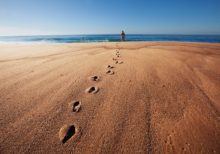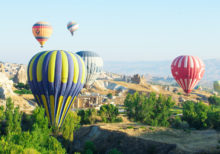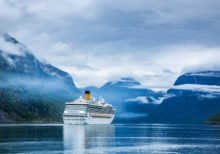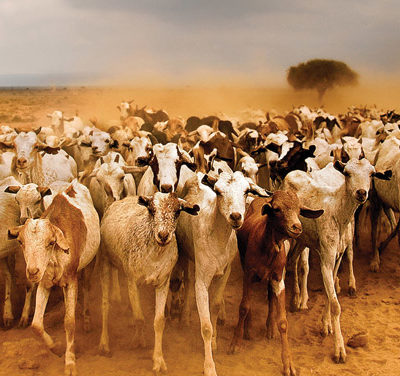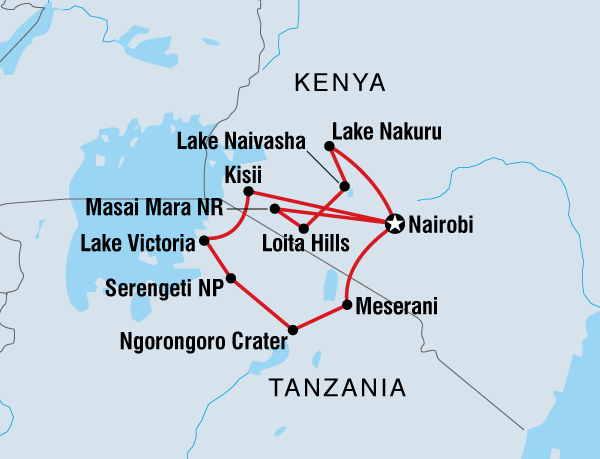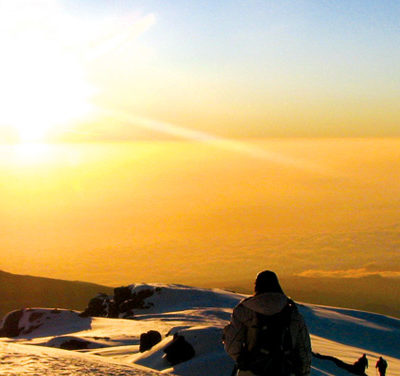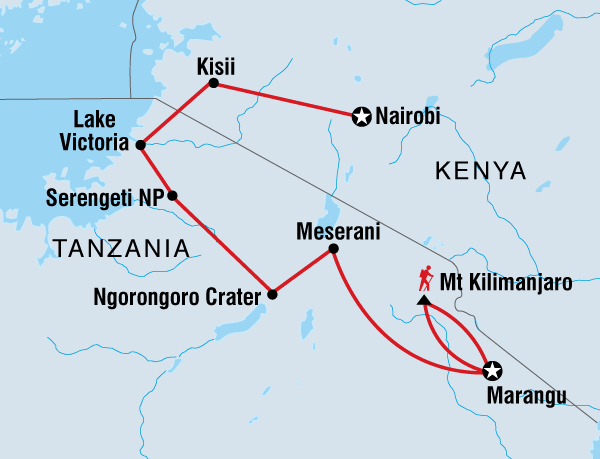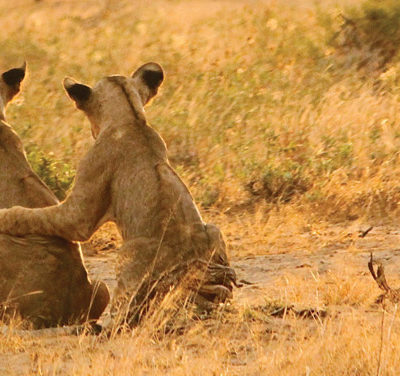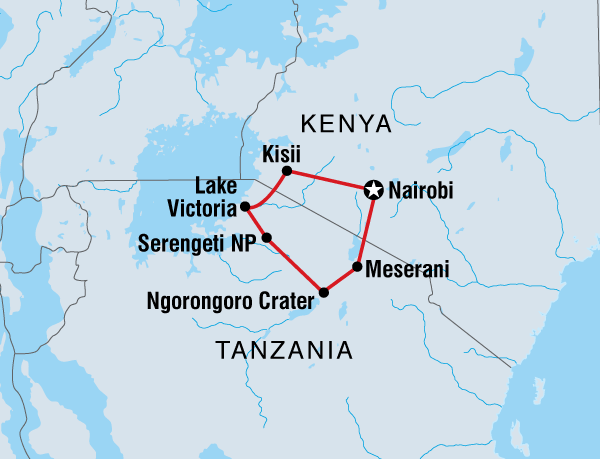| Starts | Nairobi, Kenya |
|---|---|
| Ends | Gonder, Ethiopia |
| Region | Ethiopia |
| Duration | 44 days |
| Tour Operator | Intrepid Travel |
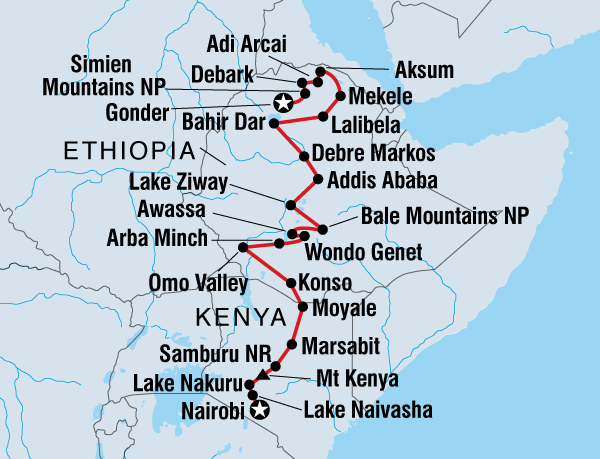
Itinerary
Day 1 - Starting: Nairobi & Finishing: Nairobi
Border Information: If joining in Nairobi, you will most likely enter Kenya at Nairobi Jomo Kenyatta International Airport (IATA code: NBO). There will be a group meeting at the joining hotel at 6:00pm. Please look out for a note from your tour leader at the reception when you arrive giving more details about this important meeting - your leader will need to check your Ethiopia visa (please see below for details). If you would like to explore Nairobi fully, we advise you arrive a day earlier, or arrive early in the morning to give yourself a full day before the meeting in the evening. Possible activities include visiting the Karen Blixen Museum, the National Museum and the Langata Giraffe Centre. Please note that many of the options listed below will only be possible for those with extra time in Nairobi before the start of your trip with us - please contact the Sales team if you would like to book pre-tour accommodation with us to have extra time exploring Nairobi. In Nairobi we will camp in the grounds of a peaceful eco-camp in the suburb of Karen. Hotel for the night: Wildebeest Eco Camp Wildebeest Eco Camp 151 Mokoyeti Road West Karen Nairobi Kenya +254 7347 70733 OPTIONAL ACTIVITIES Visit to the David Sheldrick Animal Orphanage in Nairobi : KES 500 Explore the museum at the site of the former home of Karen Blixen, the author of 'Out of Africa' : KES 1200 Visit the Langata Giraffe Centre in Nairobi : KES 1000 Learn all about the different tribal groups of Kenya at the Bomas of Kenya cultural centre in Nairobi : USD 40 Discover some of Kenya's ancient hominids at the National Museum in Nairobi : KES 1200 Head out on a guided safari walk in Nairobi National Park : USD 25 About Nairobi: Nairobi is a lively city with a cosmopolitan atmosphere. The Kenyan capital takes its name from the Maasai meaning 'Place of Cool Waters'. Today it is a busy, bustling place that comes alive through it's many markets, shops, bars and restaurants, not to mention its vibrant nightlife. If you have time to explore the city, the National Museum of Kenya and Karen Blixen Museum are both worth a visit, or you can get up close to the giraffes and help to feed them at the Langata Giraffe Centre.
Day 2-3 - Starting: Lake Naivasha & Finishing: Lake Naivasha
" Day 2 to 3 " This morning our journey begins with a short drive to Naivasha, on the shore of a beautiful calm lake in the Great Rift Valley. Here we will have the chance to take an optional boat trip on the lake to spot hippos and African fish eagles, and also to visit the Elsamere Born Free Foundation at the old home of Joy Adamson. Estimated Drive Time - 3-4 hours (please note that all drive times given here are approximate estimates only and are given with the best intentions - however please be aware that the drive times are heavily dependent on traffic, road conditions, weather, police roadblocks, and many other factors - flexibility is essential on any overland trip!). On the following day we will have free time to enjoy some excellent optional activities around Naivasha. Naivasha is the base for exploring the Crater Lake Game Sanctuary and the Hell's Gate National Park, two scenic areas that are some of the only places in East Africa where you can safely explore and look for wildlife on foot. In Naivasha we stay at a well equipped campsite on the lake shore. INCLUDED ACTIVITIES Visit the Elsamere Born Free Foundation at the former house of the conservationists Joy and George Adamson : Included in Kitty OPTIONAL ACTIVITIES Boat trip on the beautiful and serene Lake Naivasha (price for the whole boat) : KES 7000 Walking safari in the wildlife-rich Crater Lake Game Sanctuary : USD 40 Explore the beautiful landscape and wildlife of Hell's Gate National Park by foot or by bicycle : USD 50 About Naivasha: Northwest of the Kenyan capital of Nairobi lies the serene Lake Naivasha. A beautiful lake with some excellent campsites along the shore, there is the fantastic opportunity to take a calm boat trip to spot a wide variety of birds (including the African fish eagle) and the hippos that call the lake home. Naivasha is also home to the Elsamere Conservation Centre, a sustainability and conservation trust based in the former home of Joy of George Adamson, the founders of the Born Free project. Naivasha is also the gateway to the fabulous Hell's Gate National Park - a rugged and primordial landscape, Hell's Gate is full of wildlife but contains no dangerous predators, meaning that it is one of the few National Parks that visitors are able to explore on foot and by bicycle. The nearby game reserve of Crater Lake is also perfect for walking safaris amongst the wildlife of the region.
Day 4-5 - Starting: Nakuru National Park & Finishing: Nakuru National Park
" Day 4 to 5 " Today we will make our way to Nakuru, our base for tomorrow's excursion into Nakuru National Park. If we make good time on the drive we may have the opportunity to take a walk around the working dairy farm where our campsite is, and to visit a local women's knitting collective. Estimated Drive Time - 3-4 hours. On the following day we will head into Nakuru National Park for an included full-day game drive in local safari trucks. Nakuru is a beautiful park with a large lake and many forested areas - it is teeming with wildlife and there is an excellent chance to see both black and white rhinos! In Nakuru we will stay at a beautiful and well equipped campsite located on a dairy farm on the outskirts of the town. INCLUDED ACTIVITIES Take a safari in 4x4 vans in the beautiful Lake Nakuru National Park : Included in Kitty OPTIONAL ACTIVITIES Walk to explore a colonial dairy farm and visit a local women's knitting collective : USD 5 About Nakuru National Park: Lake Nakuru National Park was established in 1968 to protect the huge flocks of lesser and greater flamingos that live here. At times there are over one million of these spectacular birds roaming around the acrid waters of the soda lake that is the centrepiece of the park. Even if you are not a keen birdwatcher, the sight is inspiring and it is not hard to understand why the lake has become such a favourite for African wildlife documentaries. Nakuru is also where much of the film Out of Africa was shot. The park is located on the floor of the Rift Valley and is a mixture of bushland, forest and rocky escarpment. Each area is an important habitat for many different species of wildlife. Besides the prolific bird life, the park is also well established as one of East Africa's premier parks for big game. Beside the lake, hippo, water buck, warthogs, Bohor's reed buck and zebra can regularly be found. Further up in the forests there's a large population of black and white colobus monkeys, and the ultimate forest predator, the leopard. However, Nakuru's biggest draw is probably it's rhinos. In the late 1980s the Kenyan Wildlife Services used the park as a rhino sanctuary, and it now has a stable black and white rhino population.
Day 6-7 - Starting: Naro Moruc & Finishing: Naro Moruc
" Day 6 to 7 " Today we will head through the hills of central Kenya through the area's beautiful scenery and tea plantations, to arrive at the small village of Naro Moru at the base of Mount Kenya. Estimated Drive Time - 5-6 hours. On the following day we will have a free day in Naro Moru to take optional walks around the lower slopes of Mount Kenya, explore the nearby Mau Mau caves, or take an optional game drive in the nearby Sweet waters National Reserve. In Naro Moru we will stay at a well equipped campsite. OPTIONAL ACTIVITIES Visit the spectacular Thomson Falls at Nyahururu : Free Guided walk to the Nayaroi Caves in the foothills of Mt. Kenya, used by the Mau Mau during the rebellion against British colonial rule : KES 1000 Head out horse riding in the forests around Naro Moru : KES 1000 Nature walks around the base of Mt. Kenya, searching for bird life and Colobus monkeys : USD 15 About Naro Moru: Naro Moru is a tiny village on the western flanks of Mount Kenya, most famous as being the starting point for the most popular trekking route up the mountain. There are many activities available for short-term visitors, such as day-treks on the cool forested slopes of the mountain to look for birds and local caves used by the Mau Mau in their fight against the British in the 1950s.
Day 8 - Starting: Samburu Village & Finishing: Samburu Village
Today we will travel to the Samburu region near to the small town of Archer's Post, where we will visit a Samburu village. Here we will be shown around the village and their homes, play with the children and learn all about the way of life here for the Samburu people! We will camp in the village in the heart of the community tonight, where there are no toilet or washing facilities. Estimated Drive Time - 4-5 hours. INCLUDED ACTIVITIES Visit and stay at the Samburu tribal community and cultural project, learning all about the culture of the Samburu people : Included in Kitty About Samburu Village: We stay at a Samburu village just outside the Samburu National Reserve. Similar in appearance to the Maasai but less known, the Samburu are a proud warrior tribe. Here we watch traditional Samburu dancing, and learn about Samburu tribal life and customs. The project is run by Samburu tribesmen for the benefit of the community.
Day 9 - Starting: Samburu National Reserve & Finishing: Samburu National Reserve
Today we will get up early and enter the Samburu National Reserve, where we will head out for the entire day for game drives in the truck (breaking for a long lunch during the heat of the day). Samburu is a stunning National Reserve and is a great opportunity to spot big game such as cheetah, leopards, lions, and buffalo. The Reserve is also home to other animals rarely seen in the National Parks further south, such as Grevy's zebras, Somali ostriches and gerenuk ('giraffe-necked antelopes'). Tonight we will wild camp in a camping area in the National Reserve - facilities are very basic, but the area is a 5-10 minute walk from Samburu Lodge. Please note that during very wet conditions we may need to use locally chartered 4x4 jeeps rather than our truck to get a good game drive in - in this instance we may make this option available at extra cost. INCLUDED ACTIVITIES Head out for a wildlife safari in our overland truck through the Samburu National Reserve, in search of local wildlife including gerenuk and Grevy's zebra : Included in Kitty About Samburu National Reserve: The Samburu region has hardly been touched by tourism and its pristine wilderness is home to a fascinating mix of Kenya's nomadic tribes who still retain traditional ways of life. These tribes include the Samburu, Rendille, Turkana, and Kalenjin. The Samburu National Reserve is famous for its reticulated giraffes, Grevy's zebras, graceful gerenuks, and Beisa oryx, whilst crocodiles are often seen in the river. If we are lucky, we may also see lions or leopards here. The Ewaso Nyiro River meanders through the reserve forming a ribbon of oases in the parched landscape. We will visit the Samburu Cultural Centre outside Samburu National Reserve. Similar in appearance to the Maasai but lesser known, the Samburu are a proud warrior tribe. Here we watch traditional Samburu dancing, and learn about Samburu tribal life and customs. The project is run by Samburu tribesmen for the benefit of the community.
Day 10 - Starting: Arba Minch, Moyale & Finishing: Arba Minch, Moyale
Border Information: If you are joining in Arba Minch, you will most likely enter Ethiopia at Arba Minch Airport (IATA code: AMH) Welcome to Ethiopia! Today is the arrival day for those joining in Arba Minch, and will be a free day to explore the town. There will be a short informal meet and-greet with our local Omo Valley guide at 6:00pm today - please note that if our truck is travelling up from Nairobi, you will not meet our regular Dragoman crew until your arrival in Konso tomorrow (as they will be travelling to the town of Moyale today). In Arba Minch we will stay in a basic local hotel. Hotel for the night: Zebib Pension Zebib Pension Secha Arba Minch Ethiopia Tel - +251 4688 14788 About Arba Minch: Meaning 'forty springs', Arba Minch takes its name from the streams found between the two Rift Valley lakes of Abaya and Chamo. The town has stunning views over the lakes and surrounding forested areas, and also has an excellent and vibrant market. Lake Chamo National Park is home to what the locals refer to as the 'crocodile market'. This is a place on the shores of the lake where vast numbers of crocs congregate, some of which reach over 7 metres in length. The lake is home to the Guji and Ganjule people who traditionally hunt hippos and are famed for their 'ambatch boats', which resemble the boats carved in the tombs of the ancient Egyptians.
Day 11 - Starting: Konso & Finishing: Konso
Today we will travel to Konso, home to the local Konso people and our gateway to the very remote Omo Valley region of southern Ethiopia. If our overland truck is travelling up from Nairobi, those joining in Arba Minch will take a transfer in a locally-chartered vehicle, and will meet our Dragoman crew this afternoon in Konso - there will be an important group meeting with your leader at 6:00pm this evening. Estimated Drive Time - 3-5 hours (please note that all drive times given here are the approximate number of hours that the truck will be in motion only, and does not include any time taken for coffee or lunch stops, border crossings, photo stops, activities en route, comfort breaks, shopping stops, toilet stops, etc. The times given are approximate estimates only and whilst given with the best of intentions, the drive times are heavily dependent on traffic, road conditions, weather, police roadblocks, and many other factors - flexibility is essential on any overland trip!). In Konso we will camp in the grounds of a basic lodge. About Konso: In the far south of Ethiopia on the banks of the Sagan river is the town of Konso, the gateway to the Omo Valley. Home to the Konso people, a Cushtic-speaking people native to the region, there are many traditional Konso village in the area where little has changed about the way of life over the centuries and old traditions are strongly upheld.
Day 12-14 - Starting: Omo Valley & Finishing: Omo Valley
" Day 12 to 14 " Over the next 4 days/3 nights we will be exploring the remote and rarely visited tribal areas of the Omo Valley in southern Ethiopia. We will keep these days on a flexible itinerary so that we can react to news of special events being hosted by particular villages or tribes; as such, we cannot provide an exact itinerary for these days. However, we will aim to visit various tribal villages in the area, such as villages of the Hamer, the Mursi and the Konso tribes. We will camp in basic campsites on all these nights without possibility of upgrades, and we will try to spend at least one of the nights camping in one of the tribal villages (this is not guaranteed to be possible on every trip). Estimated Drive Times - between 4-9 hours each day. Please note that we will be travelling through very remote areas with rough roads and basic conditions on these days. Please also note that it is absolutely vital that you follow your tour leader's directions regarding responsible tourism in these regions, especially with regards to giving things away for free and taking photographs of the locals. INCLUDED ACTIVITIES Journey through the remote Omo Valley, visiting several tribal communities along the way (possibly including the Hamer, Banna, Mursi, Ari, Konso or Danesesch tribes) : Included in Kitty About Omo Valley Region: The Omo Valley region is unusual in that it is home to so many different tribal groups, all living very close to one another in such a small area. Anthropologists believe that this is because thousands of years ago this area of Africa acted as a kind of ethnic crossroads, as different groups of people migrated between north, south, east and west. Exploring the many small communities and settlements here will give you a fascinating insight into the different tribes, their cultures, traditions and way of life. On Dragoman trips we travel with a local guide, who will be able to introduce us to the Hamer, Mursi, Arbore and the Danesesch tribes. There are also other tribal groupings throughout the area and our guides will explain some of their traditions and customs. Life is distinctly tribal throughout the region, with few modern amenities
Day 15 - Starting: Arba Minch & Finishing: Arba Minch
Today we will exit the Omo Valley region and arrive in the town of Arba Minch, a small town overlooking Lake Chamo. In Arba Minch we will stay in a basic local hotel. Estimated Drive Time - 6-7 hours. OPTIONAL ACTIVITIES Hire bicycles to explore the stunning surrounds of Arba Minch : ETB 200 Take a boat trip on Lake Chamo, a stunning lake with a dense population of crocodiles : ETB 450 Visit the fascinating village of Chincha to learn all about the culture of the Dorze people : ETB 100
Day 16 - Starting: Arba Minch & Finishing: Arba Minch
On the next day, we will have a free day for some well-earned rest after the Omo Valley, or to take an optional boat trip on Lake Chamo to the view the crocodiles that reside there.
Day 17-18 - Starting: Wondo Genet/Awassa & Finishing: Wondo Genet/Awassa
" Day 17 to 18 " Today we will head north to the small town of Awassa, where we will visit the Awassa Children's Project in the afternoon. This is a home for local children orphaned by the HIV epidemic, and we will be shown around and see how public donations and the support of Dragoman goes towards feeding, sheltering and educating the children. After our visit we will head to Wendo Genet, a small town in the hills above Awassa, where we will stay for the 2 nights. Estimated Drive Time - 7-9 hours. On the following day we will have a a free day to explore the region, go on an optional walk to some nearby waterfalls, and take a dip in the nearby hot springs. In Wendo Genet we will camp in the grounds of a small local hotel. INCLUDED ACTIVITIES Visit the Dragoman-supported Awassa Children's Project, a home for orphaned children from the area : Included in Kitty Relax in the hot springs at Wendo Genet : Included in Kitty OPTIONAL ACTIVITIES Head out on a short walk to the waterfalls near Wendo Genet : ETB 100 About Wendo Genet: Wendo Genet is a resort town in Ethiopia located near Awassa. Wendo Genet is known for its hot springs and is surrounded by primary Ethiopian forests. The Wendo Genet hotel was established in 1964, on land used as recreation site for the royal family until 1975 - Emperor Haile Selassie bequeathed its name, meaning "Wendo Paradise", in reference to the beautiful panorama with a rich endowment of forests, wildlife and abundant water. About Awassa: Awassa is a small town near the Ethiopian city of Shashemene, and was the capital of the former Sidamo Province. During our time in Awassa we will visit the Awassa Children's Project, which promotes sensible, culturally responsible relief work aimed at assisting children primarily orphaned by AIDS, educating people in Africa's Sub-Saharan region about AIDS prevention, and offering a proactive and immediate approach towards the resolution of serious health and social issues facing the region. The project runs a children's centre that provides housing, food and education for over 60 children orphaned by AIDS, the One Love Theatre AIDS education theatre company, and the Awassa Youth Campus community centre in downtown Awassa. For further information on the project please go to http://www.awassachildrensproject.org/.
Day 19-21 - Starting: Bale Mountain National Park & Finishing: Bale Mountain National Park
" Day 19 to 21 " Today we will leave Wendo Genet and drive to the stunning Bale Mountains National Park. Estimated Drive Time - 4-6 hours. We will enjoy 2 full days to explore the National Park. We will keep one day completely free to head out for optional guided walks - there are several possibilities for routes, including highland routes up the hills and moorlands searching for mountain nyalas, or lowland walks through the forest areas to look for Bale monkeys! On the other day we will drive in the truck up to the Sanetti Plateau, all the way to the second-highest point in Ethiopia (the 4359m summit of Tulu Dimtu) to explore the primeval landscape and search for Ethiopian wolves. In the Bale Mountains we will stay in dorms in a basic lodge near the entrance to the National Park. INCLUDED ACTIVITIES Head out on various walks through the forests, moors, and mountains of the beautiful Bale Mountains National Park : Included in Kitty Head up to the incredible Sanetti Plateau on a day trip with our overland truck, stopping to explore the area on foot and search for Ethiopian Wolves : Included in Kitty About Bale Mountains National Park: The Bale Mountains National Park is situated on a high plateau surrounded by mountain peaks which soar to over 4,000 metres in height. As you climb into the hills the terrain changes from forest on the lower slopes, through junipers and heather, to the exotic moorlands of the plateau criss-crossed by fast flowing streams. This beautiful park is home to three species unique to Ethiopia - the Ethiopian wolf, Menelik's bushbuck and the Mountain nyala. There are some 200 species of birds within the park, including 13 of Ethiopia's 23 endemic species There are many different trekking routes around the National Park, through the forests and mountains and up onto the moorlands. The high Sanetti Plateau is accessible to vehicles, so we can also explore this high moor in our overland truck.
Day 22 - Starting: Lake Ziway & Finishing: Lake Ziway
Today we will leave the Bale Mountains and head to the small town of Ziway. After lunch we will take an included boat trip across Lake Ziway to Tulu Gudo Island, where we will have a short guided tour of the ancient monastery there and view some of the old religious manuscripts. In Ziway we will stay in a small local hotel. Estimated Drive Time - 4-5 hours. INCLUDED ACTIVITIES Take a boat trip across Lake Ziway to Tulu Gudo Island, and explore the old Coptic monastery on the island : Included in Kitty About Lake Ziway: Lake Ziway, about 100kms south of Addis Ababa, nurtures an array of wildlife. Birds, hippopotamuses and fish roam the lake, which is dotted with five islands. One of the islands, Tulo Gudo, is home to an atmospheric and colourful old Coptic Christian monastery which is said to have housed the Ark of the Covenant in the 9th Century CE.
Day 23 - Starting: Addis Ababa & Finishing: Addis Ababa
Today we will travel to the bustling Ethiopian capital of Addis Ababa, where we will have a free afternoon to explore the city. In Addis Ababa we will stay in a comfortable hotel with good facilities. Estimated Drive Time - 3-4 hours. About Addis Ababa: Referred to more commonly as simply "Addis", the Ethiopian capital of Addis Ababa lies amongst wooded hills at an altitude of about 2,300 metres, giving it a pleasant climate. Addis has many sights to offer visitors - get a fascinating glimpse into Ethiopia's many tribal groups at the Ethnological Museum, see the stunning fossil collection at the National Museum, and don't miss the chaotic bustle of the Mercato, one of Africa's largest open-air markets. All manner of arts and crafts can be found in the souvenir shops on Churchill Avenue, and there is often some excellent live music to be found in the centre of the city!
Day 24-25 - Starting: Addis Ababa & Finishing: Addis Ababa
" Day 24 to 25 " Border Information: If joining in Addis Ababa, you will most likely enter Ethiopia at Addis Ababa Bole International Airport. There will be a group meeting at the joining hotel at 6:00pm. Please look out for a note from your tour leader at the reception when you arrive giving more details about this important meeting. On the next day, we will have a free day to explore Addis Ababa and visit the city's many museums and sights. If you are travelling to the Sudan and have arranged to pick the visa up in Addis Ababa, this day will be spend arranging this visa. In Addis Ababa we will stay in a comfortable hotel with good facilities. Hotel for the night: Sarem International Hotel Sarem International Hotel Belay Zeleke Street (around Semien Mazegaja) Addis Ababa Ethiopia Tel - +251 11 126 2088
Day 26 - Starting: Debre Markos & Finishing: Debre Markos
We will start our journey today with a drive to the small town of Debre Markos. En route we will drive to the bottom of the dramatic Blue Nile Gorge and up the other side! In Debre Markos we will stay in a basic local hotel. Estimated Drive Time - 8-9 hours (please note that all drive times given here are approximate estimates only and are given with the best intentions - however please be aware that the drive times are heavily dependent on traffic, road conditions, weather, police roadblocks, and many other factors - flexibility is essential on any overland trip!).
Day 27-29 - Starting: Bahir Dar & Finishing: Bahir Dar
" Day 27 to 29 " Today we will complete our drive to Bahir Dar, a small town on Lake Tana, the source of the mighty Blue Nile. Estimated Drive Time - 5 hours. On our first day in Bahir Dar, we will have an included boat trip on Lake Tana to visit the famous old monastery of Gabriel Ure Kideth and to visit the spot where the lake outflows into the start of the Blue Nile. On our second day, we will head off in the truck to visit the Blue Nile Falls and take a short walk around the area to the historic Portuguese Bridge. We will have some free time in the afternoon to visit some other spots around Bahir Dar such as the 'Hippo bridge' and the Tigray war memorial. In Bahir Dar we will stay in decent local hotel. About Bahir Dar: Bahir Dar is a small city located on the banks of Lake Tana, a beautiful lake that is famous as the source of the Blue Nile. A few kilometres down the river from Bahir Dar are the spectacular Blue Nile Falls - locally known as Tissisat Falls (literally translating as 'water that smokes'), these waterfalls are located in a stunning area which is excellent to trek around. On the lake itself are a number of monasteries on islands and peninsulas, and we take the opportunity to visit at least one on a boat trip on the lake. These churches feature the traditional murals and decorations of the Ethiopian Coptic Church - as Christianity in Ethiopia was isolated after the emergence of Islam in the 7th Century, the religion here took a distinct style and the decorations of the monasteries of Lake Tana reflect that perfectly
Day 30-32 - Starting: Lalibela & Finishing: Lalibela
" Day 30 to 32 " Today we have a full day's drive through the beautiful scenery of central Ethiopia to reach the small medieval town of Lalibela. Estimated Drive Time - 8-9 hours. On our first day in Lalibela, we will have full day guided tour of the world famous 13th-century rock churches of Lalibela. Our guide will be able to explain the fascinating history of Lalibela and its churches, and there will be plenty of time to explore, absorb the haunting atmosphere inside the churches, and take plenty of photographs of the incredible architecture and the religious rituals within. On the second day, we will have a free day for further exploration or optional activities. We will have opportunity to hike up the nearby mountains to the Asheten Monastery, visit the Yimrehane Kristos cave church outside the town, or freely explore the Lalibela churches again at your own pace. In Lalibela we will stay in a local hotel. About Lalibela: Hidden in the hills of northern Ethiopia is the small town of Lalibela. This medieval village has grown up around 13 monolithic churches hewn from rock in the 12th Century CE. The layout and names of the major buildings in Lalibela are widely accepted to be a symbolic representation of Jerusalem, which has led some experts to date the churches to the years following the capture of Jerusalem in 1187 by Muslim leader Saladin. The rockhewn churches are an awe-inspiring feat of engineering, and each is uniquely designed and beautifully carved - the legend goes that King Lalibela completed all the work in 12 days with the help of a band of angels, but in reality the project took many years and thousands of labourers to complete. The village is small, the churches largely visited by devout Ethiopian pilgrims rather than masses of foreign tourists, and therefore retains its original Ethiopian charm and incredible atmosphere. The monastery of Asheten Mariam is hidden in the rugged hills behind the village, and there is a wonderful trek up the cliffs to reach it and take in the incredible views at the top. Near to Lalibela is the ancient church of Yemrehana Kristos, uniquely located in a cave - this can be visited during our free time in Lalibela.
Day 33-34 - Starting: Mekele, Woldiya & Finishing: Mekele, Woldiya
" Day 33 to 34 " Leaving Lalibela behind us, we have 2 days of driving through increasingly mountainous scenery to reach the town of Mekele. On the first day of this journey we aim to wild camp near the town of Woldiya or Korem. On the second day we will stay in a decent local hotel in Mekele. Estimated Drive Time - 7-8 hours each day. About Mekele: Mekele is the cultural, economic and political hub of the northern region of Tigray. Historians date the town of Mekele back to the 13th Century CE, and it is famous for its rock-hewn churches in the surrounding desert landscapes - these churches are stunning and remote, some of them dating all the way back to the 4th and 5th Centuries. We will aim to visit at least one of these atmospheric old Coptic churches on our journey through the province of Tigray.
Day 35-36 - Starting: Axum & Finishing: Axum
" Day 35 to 36 " Today we will visit one of the famous rock-hewn churches of Tigray (either the Abraha Atsbeha or Wukro Chirkos church), then continue through the increasingly breathtaking mountain scenery of the Adwa mountains to reach the ancient town of Axum in the far north of Ethiopia. Estimated Drive Time - 10 hours. The next day we will have a half day guided tour of the incredible historical sites of Axum, the capital of the once-mighty Axumite Empire - included in this tour will be seeing the Stelae Field, the Tomb of King Kaleb, and the Palace of the Queen of Sheba. We will have a free afternoon to visit other places such as the Church of St. Mary of Zion, the supposed resting place of the Ark of the Covenant. In Axum we will stay in a basic local hotel. About Axum: Axum is the site of Ethiopia's oldest city, and was once the centre of the mighty Axumite Empire. This empire flourished in the area between the 1st and 8th Centuries CE, and by the 5th Century controlled much of present-day Ethiopia, Eritrea, Somalia, Yemen and Saudi Arabia! The town retains some impressive obelisks from the Axumite era carved from single blocks of granite - the tallest still standing is 23 metres high and was probably transported by elephants from a nearby quarry. The scale of the monuments in this stelae field are testament to the enormous importance that the ancient kingdom of Axum once enjoyed. Close to the town are the extensive ruins of a palace that is said to have belonged to the biblical figure of the Queen of Sheba, who was said to have travelled to Jerusalem to test the wisdom of King Solomon. Also in the town are a complex of several ancient churches - the most famous of these is a small unimposing building known as the Church of St. Mary of Zion, which is rumoured by devout Coptic Christians to house the original Ark of the Covenant (the legendary box that contained the original Ten Commandments), although apparently only one appointed guardian is ever allowed to see it!
Day 37-38 - Starting: Debark, Adi Arkay & Finishing: Debark, Adi Arkay
" Day 37 to 38 " Leaving Axum behind us, we continue our journey with 2 days of driving through the foothills of the Simien Mountains to reach the small village of Debark, via a wild camp en route. The roads here are very tough, but we are rewarded with more truly breathtaking scenery! Debark is the gateway to the Simien Mountains National Park, and on arrival we will have a briefing from our local mountain guide explaining the various trekking options we will have during our excursion starting the following day. On the first day of our journey we aim to wild camp somewhere nearby to the village of Adi Arkay. On the second day we will stay in a basic hotel in Debark. Estimated Drive Time - 6 hours each day. About Debark: Debark is a tiny settlement that was built in the 1840s along the busy Gondar-Massawa trading route. There is not much of interest in the town, but it is the gateway to the magnificent Simien Mountains National Park and a decent place to stock up on supplies before visiting the park.
Day 39-41 - Starting: Simien Mountains National Park & Finishing: Simien Mountains National Park
" Day 39 to 41 " Today marks the start of our 3 day excursion into the Simien Mountains National Park. The area is home to some of Africa's most jaw-dropping mountain scenery and is a great opportunity to enjoy some incredibly beautiful treks and breathtaking views! The area is also home many indigenous animals, and during our time here we hope to spot lammargeyer vultures, geladas, Walia ibex, and (if we are very lucky) klipspringers and Ethiopian wolves. On each day we aim to provide an option for a long trek (of 5-8 hours), a short trek (2-5 hours) or no trekking. On our first day we aim to wild camp at the area of Sankaber. On our second and third days we aim to wild camp at the area of Chenek (underneath Ras Bwahit, the second-highest mountain in the Simiens, which we hope to get the opportunity to summit). Please note that we must keep a flexible itinerary in the Simien Mountains, as our options will largely be determined by the weather. Please also note that the camping areas in the national park are very basic, and are essentially wild camps with long drop toilets. Please also note that the food and provisions available in Debark and the national park are very limited, and it is also likely to be very cold at night, so please be prepared! About Simien Mountains National Park: The Simien Mountains are known throughout the world for their dramatic and spectacular scenery - jagged mountain peaks flank deep valleys and high altitude plains where only grasses, junipers and giant lobelias grow. The Simiens are one of the major mountain regions of Africa, home to the mountain Ras Dejen, which at 4,543m is the highest mountain in Ethiopia. The National Park was created initially as a protection area for the Walia ibex, a very agile wild goat that inhabits the area. Other wildlife that are commonly seen in the area are geladas (a baboon-type primate with long hair), klipspringers, Ethiopian wolves, and Lammageyer vultures! Perhaps the best highlight of the National Park is the phenomenal mountain scenery, best seen by trekking through the wonderful landscape - standing on top of a sharp precipice and gazing out over the magnificent landscape here will take your breath away, so it's definitely worth taking a bit of time to explore.
Day 42-43 - Starting: Gonder & Finishing: Gonder
" Day 42 to 43 " Today we head back out to the mountains to Debark, and then finally join the tarmac road again to reach the ancient royal city of Gondar! Estimated Drive Time - 7 hours. On the next day, we will have a half day guided tour of the historical sites of Gondar, including Gondar Castle, the King Fasilades' Baths and the Debre Birhan Selassie church. In Gondar we will stay in a comfortable hotel with good facilities. About Gondar: The historic city of Gondar is a magnificent city of castles and palaces, and is sometimes known as the 'Camelot of Africa'. This was once the capital of Ethiopia during the reign of King Fasilidas in the mid-17th Century, who built the incredible European-style castle in the centre of the town. Successive kings put in their own additions to this royal complex, and Gondar remained Ethiopia's royal capital until Emperor Tewodros II moved it to Magadala to the south east. On the outskirts of the town there is also the Fasilidas' Bath complex - an interesting building that stands in an artificial pool which is still filled for occasional religious ceremonies. At the Debre Birhan Selassie Church we can see the famous ceiling, which is painted with hundreds of faces of angels, and hear about the church's fascinating yet violent history.
Day 44 - Starting: Gondar & Finishing: Gondar
Border Information: if finishing in Gondar, you will most likely exit Ethiopia at Gondar Atse Tewodros Airport. Today is the end day for passengers finishing their trip in Gondar. Please note there is no accommodation included on the trip tonight. For passengers continuing their journey north on to Khartoum, the trip will continue on to Gedaref in the Sudan today. For passengers continuing south back to Addis Ababa on the Ethiopia Loop, we will leave today to reach Bahir Dar.
View Dates

